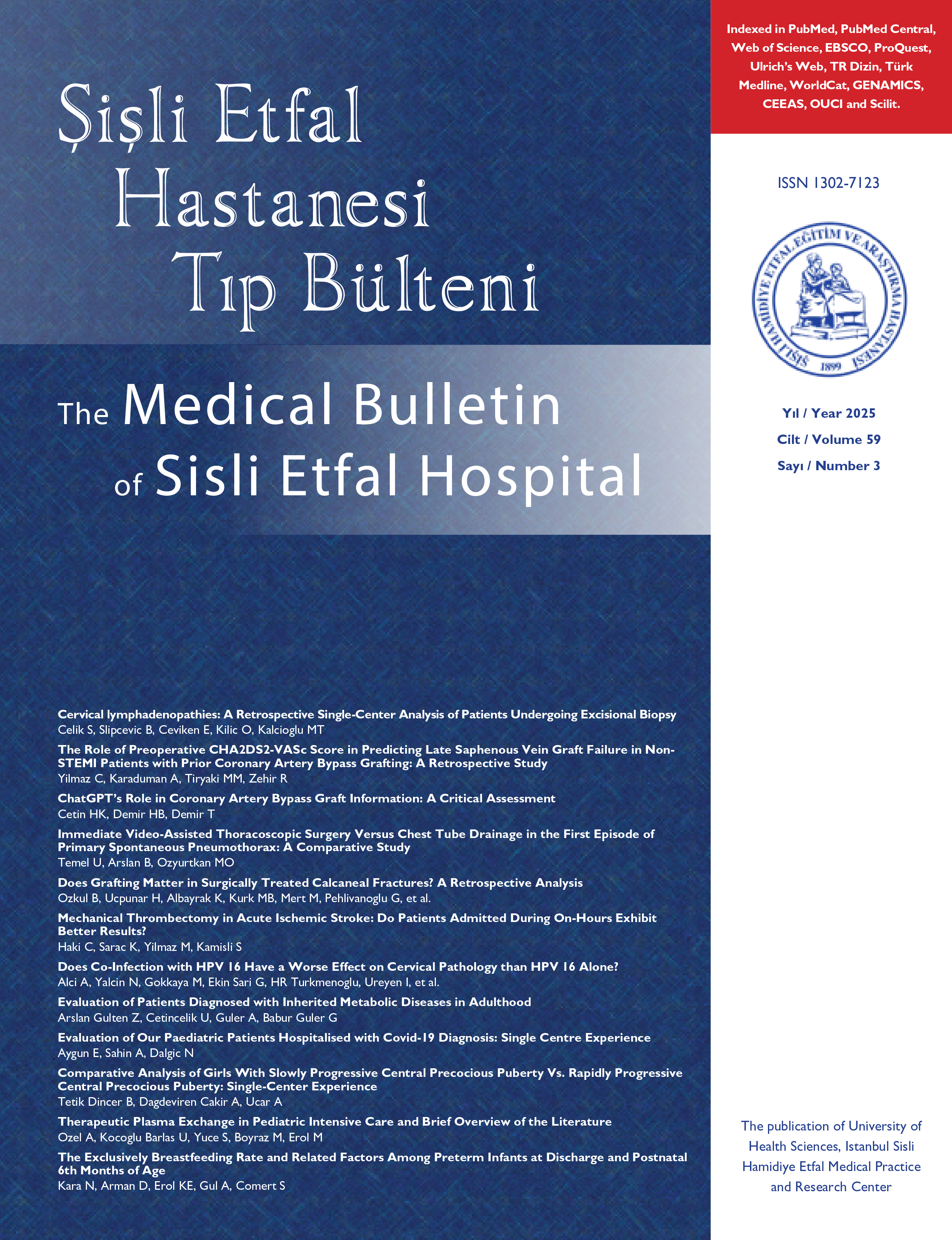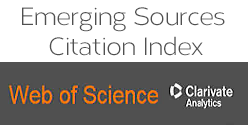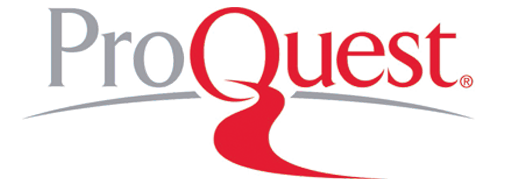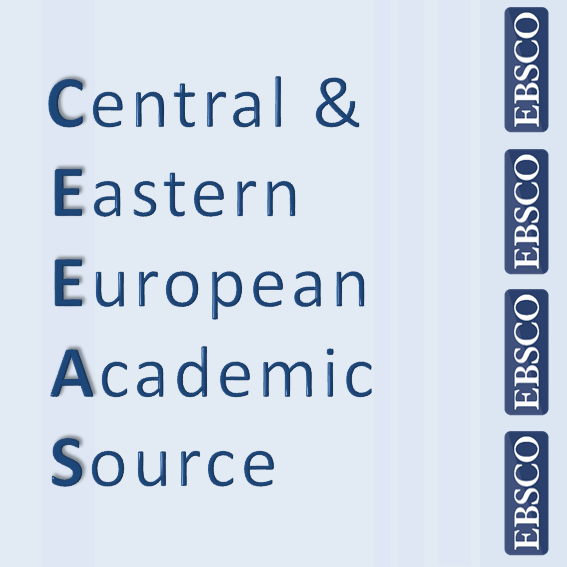
Infections Associated with the Streptococcus Anginosus Group in Children
Isil Ezel Taskin Karacay1, Gulsum Iclal Bayhan2, Tugba Erat1, Hatice Kubra Konca1, Pinar Bayraktar1, Zehra Nihan Coskun1, Selin Yildiz1, Bedia Dinc3, Aysun Yahsi11Department of Pediatric Infectious Disease, Ankara Bilkent City Hospital, Ankara, Türkiye2Department of Pediatric Infectious Disease, Ankara Bilkent City Hospital, Ankara, Türkiye; Ankara Yildirim Bayezid University Faculty of Medicine, Ankara, Türkiye
3Department of Microbiology, Ankara Bilkent City Hospital, Ankara, Türkiye
Objective: Streptococcus anginosus (SAG) group, also known as the Streptococcus milleri group, consists of Streptococcus anginosus, Streptococcus intermedius and Streptococcus constellatus. Skin and soft tissue infections, intra-abdominal infections, skeletal infections and ear-nose-throat (ENT) and cervical infection are the most common presentations. This study aimed to evaluate Streptococcus anginosus group (SAG) infections in children.
Methods: A retrospective review was conducted on patients aged 0-18 years who had cultures positive for S. anginosus, S. intermedius, or S. constellatus between January 1, 2019, and March 1, 2024.
Results: Streptococcus anginosus group (SAG) bacteria were cultured in 113 patients. SAG was identified as the causative agent of infection in 93 patients. Of a total of 93 patients, 39 were female (41.9%) and 54 were male (58.1%). The median age of the patients at the time of diagnosis was 14 years (IQR: 9-17). Among these, S. constellatus was found in 46 patients (49.5%), S. anginosus in 36 patients (38.7%), and S. intermedius in 11 patients (11.8%). The infections presented primarily as skin and soft tissue infections (63 patients), head and neck infections (23 patients), and intra-abdominal abscesses (7 patients). Additionally, two patients had concomitant bacteremia. Predisposing factors for the development of infection were identified in 52 patients (55.3%). Surgical drainage was required for 70 patients (74.4%).
Conclusion: Streptococcus constellatus was the most frequently isolated species among the Streptococcus anginosus group (SAG), followed by S. anginosus and S. intermedius. The most common site of infection was skin and soft tissue, with a significant proportion of patients requiring surgical drainage. The overall incidence of bacteremia was low S. intermedius was more frequently isolated from deep tissue infections.
Çocuklarda Streptococcus Anginosus Grubu (SAG) ile İlişkili Enfeksiyonlar
Isil Ezel Taskin Karacay1, Gulsum Iclal Bayhan2, Tugba Erat1, Hatice Kubra Konca1, Pinar Bayraktar1, Zehra Nihan Coskun1, Selin Yildiz1, Bedia Dinc3, Aysun Yahsi11Ankara Bilkent Şehir Hastanesi, Çocuk Enfeksiyon Hastalıkları Kliniği, Ankara2Ankara Bilkent Şehir Hastanesi, Çocuk Enfeksiyon Hastalıkları Kliniği, Ankara; Ankara Yıldırım Bayezid Üniversitesi Tıp Fakültesi, Ankara
3Ankara Bilkent Şehir Hastanesi, Mikrobiyoloji Kliniği, Ankara
Amaç: Streptococcus anginosus (SAG) grubu, Streptococcus milleri grubu olarak da bilinir, S. anginosus, S. intermedius ve S. constellatus'tan oluşur. Deri ve yumuşak doku enfeksiyonları, intra-abdominal enfeksiyonlar, kemik enfeksiyonları, kulak-burun-boğaz (KBB) ve servikal enfeksiyonlar en sık görülen klinik prezentasyonlardır. Bu çalışmada çocuklarda Streptococcus anginosus grubu (SAG) enfeksiyonlarını değerlendirmek amaçlandı.
Gereç ve Yöntemler: 1 Ocak 2019 ile 1 Mart 2024 tarihleri arasında S. anginosus, S. intermedius veya S. constellatus için kültürleri pozitif olan 0-18 yaş aralığındaki hastalar retrospektif olarak değerlendirildi.
Bulgular: Streptococcus anginosus grubu (SAG) bakteri 113 hastanın kültüründe üretildi. SAG, 93 hastada enfeksiyon etkeni olarak tanımlandı. Toplam 93 hastanın 39'u kız (%41,9) ve 54'ü erkekti (%58,1). Hastaların tanı anındaki medyan yaşı 14 yıldı (IQR: 9-17). S. constellatus 46 hastada (%49.5), S. anginosus 36 hastada (%38.7) ve S. intermedius 11 hastada (%11.8) enfeksiyon etkeniydi. Enfeksiyonlar, bölgelere göre deri ve yumuşak doku enfeksiyonları (63 hasta), baş ve boyun enfeksiyonları (23 hasta) ve intraabdominal apseler (7 hasta) olarak sınıflandırıldı. İki hastada eş zamanlı bakteriyemi vardı. 52 hastada (%55.3) altta yatan predispozan faktör vardı. 70 hastada (%74.4) cerrahi drenaj gerekti.
Sonuç olarak, S. constellatus, Streptococcus anginosus grubu (SAG) arasında en sık izole edilen türdü, bunu S. anginosus ve S. intermedius izledi. En sık enfeksiyon bölgesi cilt ve yumuşak dokuydu ve hastaların önemli bir kısmına cerrahi drenaj uygulanması gerekti. Çalışma popülasyonunda eşlik eden bakteriyemi insidansı düşüktü. S. intermedius derin yerleşimli enfeksiyonlarda daha sık izole edildi. (SETB-2024-09-163)
Manuscript Language: English



















